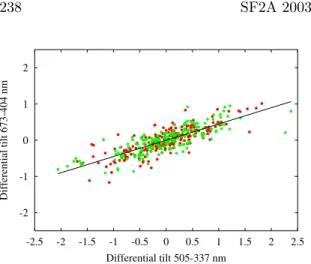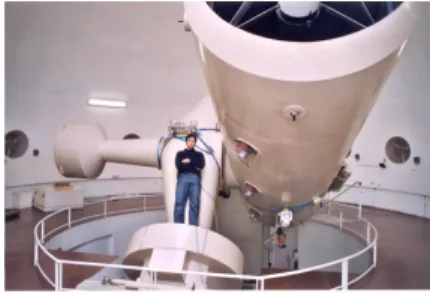HAL Id: hal-01118351
https://hal.archives-ouvertes.fr/hal-01118351
Submitted on 3 Mar 2015
HAL is a multi-disciplinary open access
archive for the deposit and dissemination of
sci-entific research documents, whether they are
pub-lished or not. The documents may come from
teaching and research institutions in France or
abroad, or from public or private research centers.
L’archive ouverte pluridisciplinaire HAL, est
destinée au dépôt et à la diffusion de documents
scientifiques de niveau recherche, publiés ou non,
émanant des établissements d’enseignement et de
recherche français ou étrangers, des laboratoires
publics ou privés.
Public Domain
Polychromatic Laser Guide Star. Progress report and
modeless laser
R. Foy, J. Girard, M. Tallon, Éric Thiébaut, J.P. Pique, S. Farinotti, M. van
Dam
To cite this version:
R. Foy, J. Girard, M. Tallon, Éric Thiébaut, J.P. Pique, et al.. Polychromatic Laser Guide Star.
Progress report and modeless laser. SF2A-2003: Semaine de l’Astrophysique Française, SFP, Jun
2003, Bordeaux, France. pp.339. �hal-01118351�
EDPS Conference Series in Astronomy & Astrophysics
POLYCHROMATIC LASER GUIDE STAR
PROGRESS REPORT AND MODELESS LASER
Foy, R.
1, Girard, J.
1, Tallon, M.
1, Thi´ebaut, ´
E
1, Pique, J.-P.
2, Farinotti,
S.
2and Van Dam, M.
3Abstract
We report the current status of the polychromatic laser guide star pro-gramme ELP-OA, and the new developments: the modeless laser allowing a continuous match of the laser FWHM with that of the Na D2 line in the mesosphere, and ATTILA the first bench of the ELP-OA demonstrator.
1 Introduction
Let us recall that the tilt of an incoming wavefront cannot be sensed with a monochromatic laser guide star (LGS)(Foy & Labeyrie 1985; Pilkington 1987). Measuring it from natural guide stars (NGS) leads to severe limitations in the sky coverage (Le Louarn et al. 1998). Indeed high return fluxes are required since ≈90% of the phase variance lie in the tilt(Rigaut & Gendron 1992). The sky cov-erage is very low at short wavelengths. The polychromatic LGS (PLGS) attempts to provide us with the tilt without any NGS, thus with a 100% sky coverage.
2 Principle
The air refraction index n varies with the wavelength, steeply in the ultravio-let. Thus, if one excites in the uppermost atmosphere a process radiating a wide spectrum, i.e.: a PLGS, then the light returned from its chromatic components follow different optical paths back to the telescope depending on the wavelength λ (Foy et al. 1995). The angle between these optical paths is the differential tilt
1
Observatoire de Lyon/CRAL, F69561 St Genis Laval
2
Laboratoire de Spectrom´etrie Physique, BP 87, F38402 Saint Martin d’H`eres
3
L-413, LLNL, PO Box 808, Livermore CA 94550
c
238 SF2A 2003
Fig. 1. The monochromatic LGS beam is deflected on its way both toward the mesosphere and back-ward. Its apparent direction is fixed with respect to the optical axis. The prism mimics the effect of the atmospheric tilt. The return light from a polychromatic LGS follows different optical paths depending on λ. From the differential tilt on de-rives the tilt.
δθ = θ δn
n−1, where derivatives are relative to λ. From the differential tilt on derives
the tilt of the incoming wavefront.
Today, the most suitable process known to create a PLGS is to excite the 4D5/2
energy level of sodium in the mesosphere. From this level a radiative cascade down to the ground level emits a spectrum with lines at 0.330. 0.569. 0.5890.0.5896. 1.14. 2.2. 2.34 µm. The shortest λ at 330 nm is short enough to get a steep variation of n − 1 and is just outside the O3 UV absorption band.
The efficiency of the two-photon resonant excitation process in the meso-sphere has already been measured on the sky (Foy et al. 2000; Sch¨ock et al. 2000). The interaction laser-sodium has been modeled with optical Bloch equa-tions (Bellenger 2002; Foy et al. 2002). Telescope vibraequa-tions can now be moni-tored on line(Tokovinin 2000). A budget link of the PLGS performances in terms of achieved Strehl ratio has been modeled(Sch¨ock et al. 2002). Here we described recent results about the accuracy of δθ measurements, the modeless laser devel-oped to get a spectral profile matching the Doppler FWHM of the Na D2 line,
and the first setup the future demonstrator of the PLGS on the sky.
3 Measurements of the differential tilt
The MaTilD experiment (Vaillant, Thi´ebaut, & Tallon 2000) aimed at measuring δθ of a 100m long beam in free air. The polychromatic source consisted of 4 spectral channels. To be free from systematic effects, we studied the correlation between δθs at 673 and 404 nm, and at 505 and 337 nm. The centers of gravity of the 4 components are now computed within circular windows centered by iteration onto the centers determined at the previous step to a fraction of a pixel. The correlation coefficient between these δθs is ≈95% (Fig. 3): the differential tilt exists !
δθ derives from the principle of separability of variables in the expression of n: n(λ, P, T ) − 1 = f (λ)g(T, P ) where P and T are the atmospheric temperature and pressure. Thus our results will hold for the vertical propagation as well. The error in δθ has to be expressed in λ/D unit, and it decreases as N2
∝D−1. Therefore
Fig. 2. Optical layout of the modeless laser. Inside the cavity oscillator, an acousto optics modulator (AOS). It breaks interferences, destroying the mode struc-ture. FP: Fabry-Perot
Fig. 3.Return flux from the modeless laser in the D2 line, as a function of the input power. Top to bottom: spectral FWHM = 3 GHz, 4.5 GHz and 1 MHz single mode.
4 The modeless laser
A major challenge of the LGS is to avoid the saturation of the absorption in the mesosphere. It can be achieved with cw lasers, as long as the power is .15 W, or with pulsed laser with widened spectral profile. The modeless laser developed for the PLGS(Pique & Farinotti 2003) provide us with a laser spectral profile which matches the Doppler profile of the D2 line in the mesosphere. The basic
originality of this oscillator is to include an acousto optics modulator in the cavity, which shifts the optical frequencies out of resonance (Fig. 2. Interferences are thus no longer possible. The temporal coherence of the laser is defined by the Lyot filter and the Fabry-Perot ´etalon in the cavity.
From experimental measurements at lab (Fig. 3), the modeless laser increases by a factor of ≈6 the return flux in the D2line with respect to a single mode laser
(by a factor of ≈3 with respect to a phase modulated one). A major operational advantage of the LSM is that the stabilization is optical. There is no servo loop. Also the output power can easily be scaled to higher values to match e.g. MCAO specs. In the case of the PLGS, a gain by a factor of & 30 is expected with respect to a single mode laser since two transitions are involved.
5 ATTILA: First step of the ELP-OA demonstrator
The ´Etoile Laser Polychromatique pour Optique Adaptative(ELP-OA) demonstra-tor begins to be implemented at the OHP 1.5m telescope. We had two observing run in Winter 2003 with its first step, the ATTILA bench; the purpose is to measure the δθ in vertical propagation. An optics setup (Fig. 4) consisting of 4 spectral channels separated with dichroic beam splitters and filters feeds a ROPER Cascade low readout noise CCD camera in situ amplified CCD camera and data processing are running. The next steps of ATTILA will be to feed on line the tip tit mirror with the signal from the pendular seismometers (Fig. 5), to correct for
240 SF2A 2003
vibrations. Then, we will feed it in addition with the tilt derived from differential tip tilt measurements. Finally we will couple ATTILA with the adaptive optics bench developed by A. Blazit.
CCD SEPARATION CHROMATIQUE COLLIMATEUR VISEUR IMAGEUR PUPILLE (Mtip−tilt)
Fig. 4. ATTILA optical setup for differential tip-tilt measurements at the OHP 1.5m telescope.
Fig. 5. The 2 pendular seismome-ters (Tokovinin 2000) mated to the OHP 1.5m telescope for vibration measurements simultaneously with differential tip tilt ones.
The first laser chain using the LSM has to be completed (intracavity preampli-fication, power supply, tests) before we run an experiment at the telescope (first toward zenith, second the telescope tracking). The second chain at 569 nm has to be built. Then we will use the 589 nm chain to feed the AO, the tilt being cor-rected with a natural guide star in a conventional way, and finally the two chains for the tilt correction. Time schedule is mostly a matter of manpower.
Bellenger V., 2002, Ph.D. thesis, Universit´e Paris VI, Paris, France Foy R., Labeyrie A., 1985, A.A., 152, L29
Foy R., Migus A., Biraben F. et al., 1995, Astron. Astrophys. Suppl. Ser., 111, 569 Foy R., Pique J.-P., Bellanger V., et al., 2002, in Wizinowich P. L., Bonaccini D. (eds.),
Adaptive Optical System Technologies II, SPIE 4839, p. 484
Foy R., Tallon M., Tallon-Bosc I. et al.., 2000, J. Opt. Soc. Am. A, 17, 2236
Le Louarn M., Foy R., Hubin N., Tallon M., 1998, Mon. Not. R. Astron. Soc, 295, 756 Pilkington J., 1987, Nature, 330, 116
Pique J.-P., Farinotti S., 2003, J. Opt. Soc. Am. B, in press Rigaut F., Gendron E., 1992, A.A., 261, 677
Sch¨ock M., Foy R., Pique J.-P., Chevrou P.,et al., 2000, in SPIE, 4007, Wizinowich P. L. (ed.), Adaptive Optical Systems Technology, p. 296
Sch¨ock M., Foy R., Tallon M., et al., 2002, MNRAS, 337, 910 Tokovinin A., 2000, MNRAS, 316, 637
Vaillant J., Thi´ebaut ´E., Tallon M., 2000, in SPIE 4007, Wizinowich P. L. (ed.), Adaptive Optical Systems Technology, p. 308


